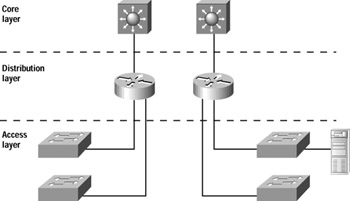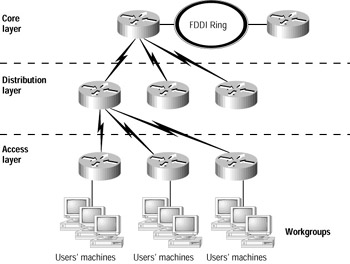Understanding the Cisco HierarchicalModel
Understanding the Cisco Hierarchical Model
Most of us learned about hierarchy early in life. Anyone with older siblings learned what it was like to be at the bottom of the hierarchy! Regardless of where we were first exposed to hierarchy, most of us experience it in many aspects of our lives. Hierarchy helps us to understand where things belong, how things fit together, and what functions go where. It brings order and understandability to otherwise complex models. If you want a pay raise, hierarchy dictates that you ask your boss, not your subordinate. That is the person whose role it is to grant (or deny) your request.
Hierarchy has many of the same benefits in network design that it has in other areas. When used properly in network design, it makes networks more predictable. It helps us to define and expect at which levels of the hierarchy we should perform certain functions. You would ask your boss, not your subordinate, for a raise because of their respective positions in the business hierarchy. The hierarchy requires that you ask someone at a higher level than yours. Likewise, you can use tools such as access lists at certain levels in hierarchical networks and you must avoid them at others.
Let's face it, large networks can be extremely complicated, with multiple protocols, detailed configurations, and diverse technologies. Hierarchy helps us to summarize a complex collection of details into an understandable model. Then, as specific configurations are needed, the model dictates the appropriate manner for them to be applied.
The Cisco hierarchical model is used to help you design a scalable, reliable, cost-effective hierarchical internetwork. Cisco defines three layers of hierarchy, as shown in Figure 1.6, each with specific functionality.

Figure 1.6: The Cisco hierarchical model
The three layers are as follows:
-
Core
-
Distribution
-
Access
Each layer has specific responsibilities. Remember, however, that the three layers are logical and not necessarily physical. 'Three layers' does not necessarily mean 'three separate devices.' Consider the OSI model, another logical hierarchy. The seven layers describe functions but not necessarily protocols, right? Sometimes a protocol maps to more than one layer of the OSI model, and sometimes multiple protocols communicate within a single layer. In the same way, when you build physical implementations of hierarchical networks, you might have many devices in a single layer, or you might have a single device performing functions at two layers. The definition of the layers is logical, not physical.
Before we examine these layers and their functions, consider a common hierarchical design, as shown in Figure 1.7. The phrase 'keep local traffic local' has almost become a cliché in the networking world. However, the underlying concept has merit. Hierarchical design lends itself perfectly to fulfilling this concept. Now, let's take a closer look at each of the layers.

Figure 1.7: A hierarchical network design
Core Layer
The core layer is literally the core of the network. At the top of the hierarchy, the core layer is responsible for transporting large amounts of traffic both reliably and quickly. The only purpose of the core layer of the network is to switch traffic as quickly as possible. The traffic transported across the core is common to a majority of users. However, remember that user data is processed at the distribution layer, and the distribution layer forwards the requests to the core, if needed.
If there is a failure in the core, every single user can be affected. Therefore, fault tolerance at this layer is an issue. The core is likely to see large volumes of traffic, so speed and latency are driving concerns here. Given the function of the core, we can now look at some design specifics to consider. Let's start with some things you know you don't want to do:
-
Don't do anything to slow down traffic. This includes using access lists, routing between VLANs, and packet filtering.
-
Don't support workgroup access here.
-
Avoid expanding the core when the internetwork grows (that is, adding routers). If performance becomes an issue in the core, give preference to upgrades over expansion.
There are a few things that you want to make sure to get done as you design the core:
-
Design the core for high reliability. Consider Data Link technologies that facilitate both speed and redundancy, such as FDDI, FastEthernet (with redundant links), Gigabit Ethernet, or even ATM.
-
Design with speed in mind. The core should have very little latency.
-
Select routing protocols with lower convergence times. Fast and redundant Data Link connectivity is no help if your routing tables are shot!
Distribution Layer
The distribution layer is sometimes referred to as the workgroup layer and is the communication point between the access layer and the core. The primary function of the distribution layer is to provide routing, filtering, and WAN access and to determine how packets can access the core, if needed. The distribution layer must determine the fastest way that user requests are serviced (for example, how a file request is forwarded to a server). After the distribution layer determines the best path, it forwards the request to the core layer. The core layer is then responsible for quickly transporting the request to the correct service.
The distribution layer is the place to implement policies for the network. Here, you can exercise considerable flexibility in defining network operation. Generally, the following should be done at the distribution layer:
-
Implement tools such as access lists, packet filtering, and queuing.
-
Implement security and network policies, including address translation and firewalls.
-
Redistribute between routing protocols, including static routing.
-
Route between VLANs and other workgroup support functions.
-
Define broadcast and multicast domains.
Things to avoid at the distribution layer are limited to those functions that exclusively belong to one of the other layers.
Access Layer
The access layer controls user and workgroup access to internetwork resources. The access layer is sometimes referred to as the desktop layer. The network resources that most users need are available locally. Any traffic for remote services is handled by the distribution layer. The following functions should be included at this layer:
-
Continued (from distribution layer) access control and policies.
-
Creation of separate collision domains (segmentation).
-
Workgroup connectivity to the distribution layer.
-
Technologies such as dial-on-demand routing (DDR) and Ethernet switching are frequently seen in the access layer. Static routing (instead of dynamic routing protocols) is seen here as well.
As already noted, having three separate levels does not have to imply having three separate routers. It could be fewer, or it could be more. Remember that this is a layered approach.
EAN: 2147483647
Pages: 174